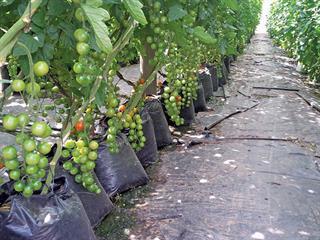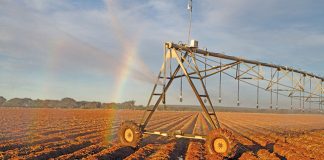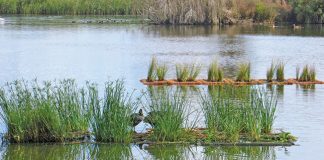
Agriculture accounts for more than 60% of South Africa’s annual total water allocation, making it the largest user of water in the country. With growing urbanisation and populations, competition for this resource is increasing, and it is likely that the sector will be allocated less water in future. Farmers therefore have to become more efficient in the way they utilise water.
One solution is to improve crops’ water use efficiency (WUE) through nutrition, says Gerrit Burger, an agronomist at Haifa South Africa. The international Haifa Group develops and supplies potassium nitrate (KNO3) and speciality plant nutrients.
The group has developed a refinement of fertigation, trademarked ‘nutrigation’. Where fertigation simply supplies water-soluble nutrients to plants, nutrigation supplies nutrients according to a plant’s needs and development.
This concept, and its contribution to WUE, was spelt out by Burger at the Undercover Farming Conference held in Cape Town recently. Any chemical element deficiency induces plant stress, resulting in sub-optimal growth, explains Burger. This in turn has a negative impact on the relationship between crop growth and water uptake.
Because most crops require large amounts of nitrogen (N) and potassium (K), a deficiency of these two elements has a dramatic effect on WUE. This is due mainly to their roles in the regulation of photosynthesis and evapotranspiration.
Where deficiencies are present, potassium nitrate can boost yield by 10% to 35% on a given water quota, says Burger.
Potassium
Potassium is a key role player in osmosis regulation. Put simply, osmosis is a plant’s ability to take up water through its roots and transport it to other parts of the plant. Potassium is also involved in the opening and closing of stomata in leaves, which helps to regulate evaporation. This affects stomatal conductance – the rate at which carbon dioxide enters, and water vapour exits, the stomata.
Studies on various crops, from oranges to wheat, have shown that a potassium deficiency increases transpiration in crops subjected to water stress, compared with crops with adequate potassium levels under similar conditions. “In crops with adequate potassium, the stomata react very quickly to water-related stress by reducing evaporation levels. This results in plants recovering faster from heat-related stress than plants with inadequate levels of potassium,” Burger explains.
In addition, a deficiency in potassium will lead to higher stomatal conductance, which reduces WUE. “In water, sodium (Na) raises the electro-conductivity (EC) and competes directly with potassium for enzymatic binding sites,” he says. “Farmers must therefore ensure the correct ratio between these elements to offset potential problems arising from a high sodium level. The absolute amount tolerable will depend on crop sensitivity as well as the prevailing growing conditions.”
He uses the metaphor of a busy train station to illustrate the result of irrigating with water with an undesirably high EC.
“When unwanted elements such as sodium are present in such water, it causes the ‘station’ to be more congested, resulting in a bottleneck for nutrients moving into the train (the root), and into the plant. Depending on the water quality that you start off with, the ideal EC of nutrigation water should be between 1,6mS/ cm and 2,4 mS/ cm, depending on the crop and growth stage.”
A study on avocados found that potassium could reduce chloride (Cl) toxicity in water. The water in the study had a high chloride content of 16mmol/l. Owing to an increase in the water’s potassium level, crop health increased significantly. Plants receiving 16mmol/l potassium (in the form of potassium nitrate) showed very little evidence of chloride toxicity.
The role of Nitrogen
Nitrogen, specifically in the form of nitrate (NO3), is important in WUE. Higher levels of nitrate have been shown to increase production per unit of nitrogen applied. Photosynthesis uses light energy to convert water and carbon dioxide into glucose and oxygen. Oxygen is released through the leaves, while the energy is used for plant growth, flower formation and fruit development. There is also a direct relation between photosynthesis and cell respiration.
Nitrate’s impact on WUE is even greater when combined with potassium, explains Burger. Nitrate reduces chloride absorption in plants. Chloride suppresses nitrate in the same way as sodium suppresses potassium uptake. As an example, a study with tomatoes found that WUE was greatly improved in tomatoes through potassium nitrate nutrigation.
In the study, tomato plants receiving 6,3g potassium nitrate/plant yielded 2 550g/ plant, and used about 23ml of water per gram of fresh fruit. Plants receiving 12,6g potassium nitrate/ plant yielded 3 430g tomatoes/plant, with the same WUE efficiency as when 6,3g was used.
WUE was significantly lower when the ammonium content was increased. Tomato plants receiving 6,3g potassium nitrate and 4,4g ammonium nitrate/plant produced a yield of 1 980g/plant, while using 28ml water to produce one gram of fresh fruit.
When the same amount of potassium nitrate was used with 8,7g ammonium nitrate, yield fell to 1 200g/ plant, with water use increasing to 29ml to produce one gram of fresh fruit. Efficiency was lowest when the same amount of potassium nitrate was used with 13,2g of ammonium nitrate/plant. These plants produced 1 000g of tomatoes/plant, using 34ml of water to produce 1g of fresh fruit.
This shows that an increased NO3:NH4 (nitrate : ammonium) ratio favours production and WUE efficiency in tomatoes.
Potassium nitrate has also been found to increase yield and saline resistance under saline conditions. Chinese cabbage plants receiving no potassium nitrate at an electro-conductivity of 5mS/cm produced about 900g/plant. Those receiving 1mmol/l of potassium (in the form of potassium nitrate) yielded about 800g/plant, at an electro-conductivity of 5,5mS/cm.
Plants receiving 5mmol/l of potassium nitrate produced almost 1 180g/plant, at an electro-conductivity of 6mS/ cm, and plants receiving 10mmol/l potassium (in the form of potassium nitrate) produced about 1 020g/plant, at an EC of 6,5mS/cm.
Soil-specific programme
According to Burger, the ideal fertiliser programme would match the plant’s nutrient demand at each developmental stage.
The growing conditions, soil or substrate characteristics, in addition to water quality, are of great importance when putting a nutrigation programme together. In addition, farmers must make provision for the nutrients that are already available in their water.
Phone Gerrit Burger on 021 982 0309 or 082 800 8766, or email him at [email protected]













